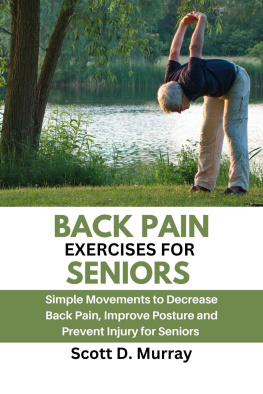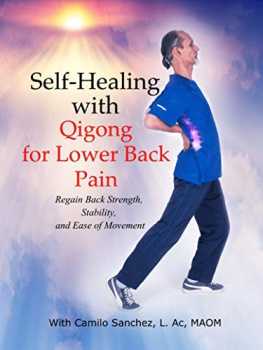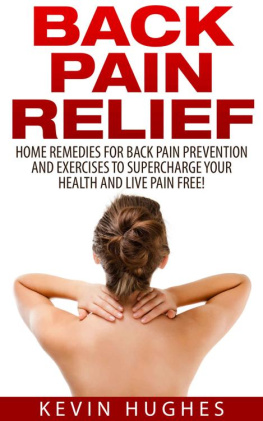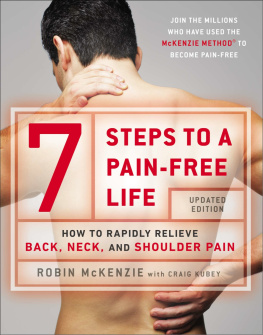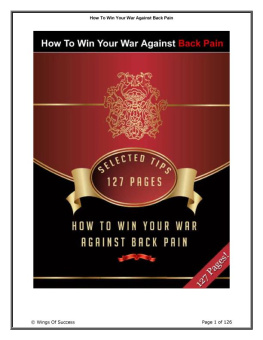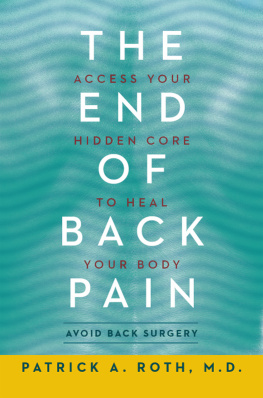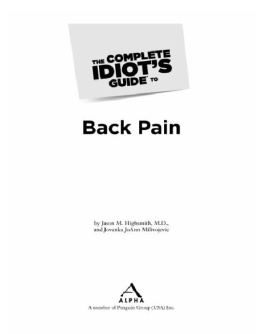G ERARD G IRASOLE , M.D. AND C ARA H ARTMAN , CPT
INTRODUCTION
C OMEDIANS USED TO JOKE about headaches when they said, Not tonight, honey. But they got it wrong. Back pain is the real passion killer.
Dealing with this pain is not just about personal sufferingits an enormous issue with grave implications for the economics of the workplace and our struggling health-care system. The statistics are telling: at least 80 percent of all adults suffer from a bout of lower back pain at some point in their lifetime, with over thirty-one million Americans in pain from backaches at any given time, and nearly one-quarter of all American adults experiencing at least one day of back pain every three months.
Because you use your back in so much of what you do, and because back pain is often so debilitating, it is second only to the common cold as a cause of lost time from work, and it causes more loss of productivity in the workplace than any other medical conditionto the tune of fifty billion dollars in losses each year just in the United States. According to Understanding Pain, the cover story of the March 7, 2011, issue of Time magazine, lower back pain accounts for ninety-three million workdays lost every year. It consumes over five billion dollars in health-care costs.
Yet for such a common and chronic problem, the treatment and management of back pain is often rife with misinformationwhich can lead to inappropriate treatments. I can say that because as an orthopedic surgeon specializing in spines, I hear it firsthand from my patients. I know how they feel because I am a back pain sufferer myself. Back pain is an occupational hazard for surgeons, who bend over patients for hours on end in the operating theater.
So I can empathize with how back pain can make you feel as if you are a prisoner in your own body. It can ruin your life, your marriage, your ability to concentrate at work and even your recreation time with your family (try going on the rides at Disney World when you cant walk without wincing!). It can make you too frightened to drive (what if your back seizes up and its agony to move your foot off the gas pedal?), too worried to have sex (what if you get stuck in a compromising position while in the throes of passion?) and even too embarrassed to get down on your knees to pray in your house of worship (what if it hurts too much to get up again?).
This pain can be compounded by the skeptical or cruel comments made about the amount of pain youre in. Back pain isnt a visible wound. But just because your boss or loved ones cant see it doesnt mean it isnt there.
The patients who come to me all have one thing in common: they are very frightened that their pain means they have a permanently debilitating and serious injury, and that they will be living with pain for life. I know that many of these patients had put off seeing a medical professional because either they couldnt afford a series of visits in our current economy or they automatically assumed they would need surgery and were too afraid to get to the root of their problem. So they self-medicated or tried all sorts of treatments that, over time, only made things worse. Had they come to a spine specialist first, they might have gotten at least some instant psychological relief as they would have been told what youre going to learn in this book, which is that most people with lower back pain do not need surgery or even physical therapy in order to get better and live pain-free lives.
I explain to these patients that sometimes there is absolutely no way to know that their back is about to start throbbing, so they should stop blaming themselves for the situation. The pain can come on when you hit a golf ball the wrong way, pick up your fussing toddler or bend over to tie a shoelace. It can come on when you are sitting at your desk, watching TV or having a slow stroll down the street after dinner.
Other times, back pain starts due to a muscle imbalance. Perhaps your abdominal muscles are stronger than your opposing back muscles, and over time the back muscles just cant handle the stresses put on them. Or these muscles may be strong, but you twist or turn or bend over the wrong way when youre hurrying through the airport or lifting a weight that is too heavy at the gym.
Back pain can also occur because you exercise too little or too much. Or your posture at work might be the culprit. Its hard to remember to sit tall when your workstation is all wrong for your height, but if you sit hunched over at your desk for long periods, your muscles will invariably tense and tighten.
When youre in pain, though, all you want to do is get out of it. This book will make the fear of back pain and the panic disappear, as it will tell you what to do, why youre doing it and how to move precisely in that moment and for that particular situation no matter where you are and what youre doing, and no matter how mundane the task at hand. Armed with this knowledge, you will be able to move and to manage the situation. You will no longer experience panic, which can be as debilitating as the pain itself.
Even better, this book will not only bust the myths about back pain but give you a foolproof, daily system for strengthening your back so that bouts of back pain are much less likely to recur.
HOW THE 7-MINUTE BACK PAIN SOLUTION CAME TO BE
Ive lost track of how many patients over the years have begged me for a take-home program they could easily follow. They often went for professional treatments (chiropractic, physical therapy) and got temporary relief, but they couldnt continue to get great results at home, when they needed them most. This is incredibly frustrating to me and to my colleagues. Our patients suffer and spend a lot of money to get betterwhile being forced to take time off from work and from their daily livesyet once they start to heal, they have no idea what to do to maintain or strengthen their backs.
I was thinking about how to solve this dilemma about seven years ago, when a patient named Cara Hartman told me about a sneeze.
Twenty years ago, shortly after the birth of her son, all it took was one sneeze for Caras back to go into spasms. (Yes, sneezing and coughing can be triggers for pain, just as shoveling snow or playing too much golf on a sunny day can be triggers.) The pain was so unbearableworse, she told me, than her drug-free childbirththat she was shocked when the physician in the ER told her she had only sprained her lower back. After a month of taking potent prescription painkillers and living in fear that she would never be pain free, she slowly got better. However, the pain suddenly returned several months later, this time radiating down from her right buttock to behind her knee. She couldnt stand up straight, her hips were visibly uneven and it hurt just to breathe. Her local orthopedic surgeon looked at her X-rays and MRI, then told her that she had degenerative disc disease and that if it worsened, she might need surgery to fuse her vertebrae together to lessen the pain and degeneration.
Declining such a radical step, Cara barely managed to cope; the pain was so fierce, she couldnt bear to be touched, which put a tremendous strain on her marriage. She joked to me that she frequented chiropractors as if they were hairdressers, but while their manipulations gave her some relief, her chiropractors offered no preventative measures, such as stretches or exercises she could do on her own once she left their offices.
After an episode of pain so severe it left her stranded on her bedroom floor for two hours, she came to see me. When I viewed her MRI, I saw several degenerative, bulging discs. I was able to allay her fears by telling her that many people suffer from these issues, and that proper therapy might alleviate the pain.


